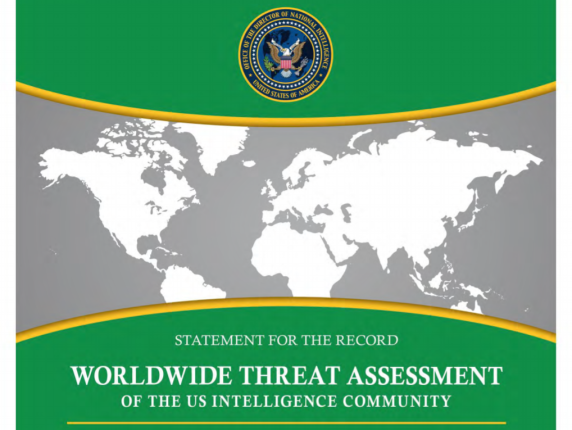-
U.S. Intelligence Community Recognizes Climate Change in Worldwide Threat Assessment
February 5, 2019 By Isabella Caltabiano
The 2019 Worldwide Threat Assessment of the US Intelligence Community, released on January 29, mentions climate change as a threat that is “likely to fuel competition for resources, economic distress, and social discontent through 2019 and beyond.” The report features new topics such as election interference and threats to economic competitiveness while still including continuing threats such as cyber espionage and attacks, terrorism, and climate change. As a statement from Director of National Intelligence (DNI), Daniel R. Coats, for the Senate Select Committee on Intelligence, the assessment provides an overview of the national security threats facing the nation.
While climate change and migration were not discussed in the hearing where the report was unveiled, the 2019 Worldwide Threat Assessment does mention human displacement, environment, and climate change, grouping them together with global health and religious freedom concerns under human security. The report acknowledges the “negative effects of environmental degradation and climate change.” By once again including climate change as a global threat, the U.S. intelligence community recognizes the issue at a time when the Trump Administration has been rolling back regulations designed to slow the pace of climate change. Sherri Goodman, Senior Fellow at the Wilson Center, said that the report signaled to those in the field that “intelligence community leaders know that climate change is a continuing threat multiplier, amplifying other risks we face around the world.”
What Was Actually Addressed
While Coat’s 2019 National Intelligence Strategy (NIS) only briefly addressed environmental security concerns, the inclusion of climate change security in the Worldwide Threat Assessment suggests that the U.S. intelligence community has not completely forgotten about water and food insecurity or extreme weather. First, the report mentions human displacement as a security issue but does not provide any reasons for the mass and record high migration. It then goes on to warn of extreme weather events, high temperatures, and diminishing Arctic sea ice along with the potential for increasing water and food insecurity, accelerating sea level rise, and increased competition over access to sea routes and natural resources.
Although many environmental threats and potential outcomes are listed, the specific focus is on extreme weather events that can “affect urban coastal areas and damage communication, energy, and transportation infrastructure” as well as “changes in the frequency and variability of heat waves, droughts, and floods increasing the risk of social unrest, migration, and interstate tension.” The report also covers Arctic issues, such as increased competition between China, Russia, and the United States over access to sea routes and natural resources as sea ice melts.
What’s Different This Year
In contrast, the 2018 Worldwide Threat Assessment warned of similar concerns about climate change but its scope was more narrow, discussing only warming climate, air pollution, biodiversity loss, and water scarcity. These topics echoed those mentioned in the 2017 threat assessment and did not stray from the four issues. In contrast, the 2019 threat report attempted to include nearly all environmental threats when it stated:
Climate hazards such as extreme weather, higher temperatures, droughts, floods, wildfires, storms, sea level rise, soil degradation, and acidifying oceans are intensifying, threatening infrastructure, health, and water and food security. Irreversible damage to ecosystems and habitats will undermine the economic benefits they provide, worsened by air, soil, water, and marine pollution.
The decision to widen the scope of perceived environmental threats suggests that the intelligence community has chosen to take a more comprehensive position on climate change than the current administration. Climate change is not the only subject of contention between the U.S. intelligence community and the White House. By warning of its threats and the consequences of global warming in this national report, the intelligence community took a direct stand against the current administration. Their Worldwide Threat Assessment acknowledges how intertwined these environmental issues are and the undeniably greater impact they can have on America’s national security.
Isabella Caltabiano is a research assistant at the Wilson Center.
Sources: U.S. Office of the Director of National Intelligence, Washington Post
 A Publication of the Stimson Center.
A Publication of the Stimson Center.



